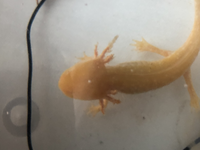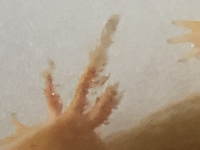jmlotl
New member
Hi all. First of all, thank you for sharing your experiences on this site — it's very helpful, even if sometimes disputatious!
My son's beloved 7-month-old 'golden albino' axolotl Sunny has hit a rough patch. About a month ago, I noticed she was making many trips to the surface for air, combined with diminished appetite (liked pellets a little, but spat out worms, even once cut up). The water parameters were OK, but I had just added sand that I believe I failed to adequately rinse (I swear I tried!). Then a few days I checked and ammonia and nitrates were high-ish (0.5/40, nitrite at zero) and I live in a city where the water comes out of the tap very hard and with a pH of around 9, which I know can worsen ammonia's effect — I've tried to tame it with IAL/IAL extract.
After those tests, and a week or so of her eating less and less, I moved her to a tub. Have been doing daily water changes, and tried a day of tea-bath therapy, since it seems relatively low-risk. But she is still not eating like she used to — no worms at all, pellet or two every couple of days. And a stalk of (apparent?) fungus on one of her gills (pictured below) has only gotten longer after, say, 100 hours in the tub. What do the salamander sages recommend?
I'm not super-alarmed, since she's acting relatively normal now (a little sedate, maybe) and has stopped her manic trips to the surface. But maybe I should be? I have gone through worrying about sand-related impaction (her belly was almost bloated; she pooped twice, now she's almost too thin, I guess), ammonia/nitrate poisoning (she had had unusually reddish eyes, and the worrisome recent tests), and then the fungus. In short, I just don't know whether I should...
• Just stick to the tub for a while
• Try fridging or salt (both super-divisive on this forum, I would argue!)
• Or try some sort of other chemical treatment some people favor.
Let me know what you think? Thank you!
My son's beloved 7-month-old 'golden albino' axolotl Sunny has hit a rough patch. About a month ago, I noticed she was making many trips to the surface for air, combined with diminished appetite (liked pellets a little, but spat out worms, even once cut up). The water parameters were OK, but I had just added sand that I believe I failed to adequately rinse (I swear I tried!). Then a few days I checked and ammonia and nitrates were high-ish (0.5/40, nitrite at zero) and I live in a city where the water comes out of the tap very hard and with a pH of around 9, which I know can worsen ammonia's effect — I've tried to tame it with IAL/IAL extract.
After those tests, and a week or so of her eating less and less, I moved her to a tub. Have been doing daily water changes, and tried a day of tea-bath therapy, since it seems relatively low-risk. But she is still not eating like she used to — no worms at all, pellet or two every couple of days. And a stalk of (apparent?) fungus on one of her gills (pictured below) has only gotten longer after, say, 100 hours in the tub. What do the salamander sages recommend?
I'm not super-alarmed, since she's acting relatively normal now (a little sedate, maybe) and has stopped her manic trips to the surface. But maybe I should be? I have gone through worrying about sand-related impaction (her belly was almost bloated; she pooped twice, now she's almost too thin, I guess), ammonia/nitrate poisoning (she had had unusually reddish eyes, and the worrisome recent tests), and then the fungus. In short, I just don't know whether I should...
• Just stick to the tub for a while
• Try fridging or salt (both super-divisive on this forum, I would argue!)
• Or try some sort of other chemical treatment some people favor.
Let me know what you think? Thank you!


